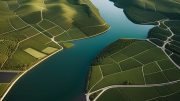Disclaimer: I know people and have friends that push pixels for a living, at least I did at the time of this writing.
The North American Imagery Program (NAIP) is a productive use of our federal tax dollars. NAIP is a program that is run by the United States Department of Agriculture (USDA), with a primary purpose of ensuring compliance in agriculture. Since many crops are subsidized and insured in this country, the NAIP conducts flights to image crops during the growing season in states that grow a large number of crops.
The imagery is used (remote sensed) to make sure that “Farmer Joe” is getting subsidies for the right crop. Typically, the imagery taken at a resolution of 2 meter pixels. However, every 5 years, generally, a state may be surveyed at the higher 1 meter pixels resolution. Once the imagery is certified by NAIP, it is released for public consumption via many sources, including Geospatial Data Gateway (GDG), a service run by the United States Department of Agriculture’s (USDA) through a close partnership between the three Service Center Agencies (SCA); Natural Resources Conservation Service (NRCS), Farm Service Agency (FSA), and Rural Development (RD).
NAIP and the GDG can be used to develop and train in-house staff on various geoprocesses, data management, data storage management, and understand the length and breadth of the associated processes. This approach can be very successful, and actually can yield quickly useable, realistic results. For those companies that have a reasonable number of geospatial analysts, one approach is to pick someone every year, and give them exposure to the NAIP and ask have them certain counties for a State or Area of Interest (AOI).
They would start by accessing the GDG, looking at the current year’s data, and begin downloading it. The GDG throttles how much data can be downloaded at once. Nonetheless, this would help the analyst start learning how to allocate resources, and manage time, with respects to keeping the downloads as continuous as possible.
Once the data is in house, a number of different applications and processes can be performed against the data. Some of these processes include understanding when pixels overlap from multiple images, how to choose which one you want to keep; how to ignore certain values (for example, black collars); and set up a workflow for the newly compiled image. “Rinse and repeat” these processes against other portions of the available data.
With analysts having a mature understanding to geospatial data processing, companies should enture that they working with the IT Infrastructure group on provisioning enough free storage capacity, such that it allows the analysts to combine several very large images (often over 100GB per image).
At this point the analyst can take ownership of the data set. Luckily, the actual time an analyst spends at the keyboard is relatively small. The majority of time is taken up with computer processing. However, analysts will check frequently to make sure the process is still running.
Once processed, the newly compiled data would get loaded into an image server, file share, webservice, or someone other device that can distribute and share the new aerial image for other users to utilize.
Ideally, processing of the NAIP data should take place every year. Analysts can look at images from the past and the current ones to see what had changed. In combination, there are great benefits for end-users, while providing each with a realistic learning experiences for internal analysts who want to be developed, and utilizing available resources .
The outcome of this process of training is to develop analysts who are capable of:
• Project management;
• Learning from mistakes;
• Learn new skill sets;
• Being aware of public datasets;
• How to improve analysts on their use and understanding of how data is formatted and transformed; and of course
• Taking pride in their work.



Be the first to comment on "North American Imagery Program and How to Develop Your Staff"